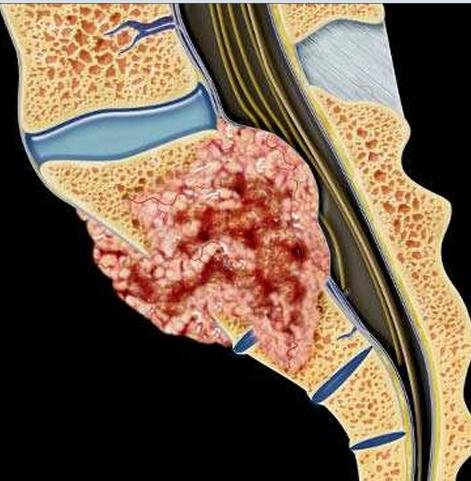Ewing's Sarcoma
Ewing's Sarcoma
Pediatric spinal Ewing's sarcoma is a rare but aggressive malignant bone tumor that affects the vertebrae in children and adolescents. Representing part of the Ewing sarcoma family of tumors (ESFT), this malignancy often arises in the spinal column’s vertebral bodies, posing significant risks due to its potential to invade the spinal cord and surrounding tissues. In Bangladesh, early diagnosis and comprehensive treatment of spinal Ewing's sarcoma in children remain challenging due to limited awareness, lack of specialized oncology-neurosurgery collaboration, and resource constraints. Dr. Md. Nafaur Rahman, a leading pediatric neurosurgeon, provides expert surgical care alongside oncologists to ensure the best outcomes for children affected by this serious condition. What is Pediatric Spinal Ewing's Sarcoma? Ewing's sarcoma is a high-grade malignant tumor primarily originating from primitive neuroectodermal cells in bone or soft tissue. When it involves the spine in children, it primarily affects the vertebral bodies, but can extend to the posterior elements and adjacent soft tissues. Key Characteristics: Most commonly affects children and adolescents aged 10–20 years Rapidly growing and locally aggressive tumor Potential for spinal cord compression causing neurological deficits Frequently requires multimodal treatment including surgery, chemotherapy, and radiotherapy Causes and Risk Factors The exact cause remains unknown; however, a specific chromosomal translocation t(11;22)(q24;q12) is commonly associated No known environmental or hereditary risk factors are conclusively linked Not contagious or related to trauma Early detection is crucial to prevent metastasis Clinical Presentation in Children Symptoms of spinal Ewing's sarcoma are often insidious and may mimic other spinal disorders, leading to delayed diagnosis: Localized spinal pain that worsens over weeks to months Swelling or palpable mass over the spine in some cases Neurological symptoms: weakness, numbness, or tingling in limbs Gait disturbances and difficulty walking Bladder or bowel dysfunction if spinal cord compression occurs Fatigue and unexplained weight loss may also be present In Bangladesh, such symptoms can be mistaken for tuberculosis of the spine (Pott’s disease), pyogenic infections, or common musculoskeletal conditions, delaying appropriate treatment. Diagnostic Approach in Bangladesh Early and accurate diagnosis of pediatric spinal Ewing's sarcoma involves a combination of clinical, radiological, and pathological evaluations. Clinical Evaluation Detailed neurological assessment Physical examination for spinal tenderness or deformity Imaging Studies X-rays: may show bone destruction or periosteal reaction MRI spine: crucial for assessing soft tissue involvement, spinal cord compression, and tumor extent CT scan: to evaluate bone integrity and plan surgical approach Whole-body bone scan or PET scan: to detect metastasis Biopsy: mandatory for histopathological diagnosis and immunohistochemical studies Treatment Protocols in Bangladesh Management of pediatric spinal Ewing's sarcoma requires a multidisciplinary team including pediatric neurosurgeons, oncologists, radiologists, and rehabilitation specialists. Surgical Management by Dr. Md. Nafaur Rahman Surgery aims to decompress the spinal cord, stabilize the spine, and achieve maximum tumor resection without causing neurological harm. En bloc resection may be possible in select cases, depending on tumor size and location. Use of microsurgical techniques and intraoperative neuromonitoring ensures safety and precision. Postoperative spinal stabilization with instrumentation may be necessary. Chemotherapy and Radiotherapy Systemic chemotherapy is essential for controlling local disease and preventing metastasis. Radiotherapy is often used as adjuvant therapy post-surgery or when surgery is not feasible. Protocols follow international pediatric oncology guidelines but are adapted considering local resources. Prognosis and Outcomes Early diagnosis and complete surgical resection combined with chemotherapy significantly improve survival rates. Prognosis depends on tumor size, metastasis, and neurological status at presentation. Long-term follow-up is necessary to monitor for recurrence and manage late effects of treatment. Rehabilitation enhances functional recovery and quality of life. Challenges Specific to Bangladesh Limited awareness about pediatric spinal tumors among primary care providers High prevalence of spinal infections leading to misdiagnosis Restricted access to advanced imaging and pediatric oncology centers outside Dhaka Financial constraints impacting treatment adherence and follow-up Need for enhanced multidisciplinary pediatric oncology-neurosurgery collaboration Why Choose Dr. Md. Nafaur Rahman? Expert pediatric neurosurgeon with specialized training in spinal tumor surgery Access to advanced operative facilities at National Institute of Neurosciences & Hospital (NINS) and Bangladesh Paediatric Neurocare Centre Comprehensive care approach including preoperative planning, surgical intervention, and postoperative rehabilitation Compassionate and ethical care tailored to children and their families Active involvement in educating healthcare professionals and raising public awareness on pediatric spinal tumors in Bangladesh Appointment & Contact Information Dr. Md. Nafaur Rahman Assistant Professor, Pediatric Neurosurgery National Institute of Neurosciences & Hospital (NINS) Chief Consultant, Bangladesh Paediatric Neurocare Centre 📞 For Appointment / Serial: 📱 01912988182 | 01607033535 🌐 Website: www.neurosurgeonnafaur.com










